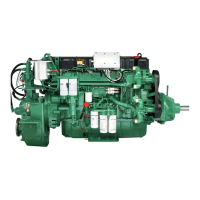D
Group 20
The larger the cooling surfaces used in the exhaust and
silencer system, the greater the amount of white smoke
when cold starting and at low outside temperatures.
White smoke may also be increased if the preheaters do
not function at cold start.
Internal coolant leaks can introduce coolant into the
combustion, resulting in white smoke.
Gray Smoke
Gray smoke is a mixture of black smoke and water vapor
and appears often in cold weather. Therefore, fault tracing
procedures for black smoke can also be used for gray
smoke. See “Black Smoke” page 26.
The following checks should be performed in order until
the fault is found. These checks also can help exclude
components with no faults or malfunctions. The amount
and sequence of checks depend on results from Basic
Checks (including active or inactive fault codes noted),
vehicle conditions, vehicle service and repair history,
other symptoms, and information from the driver.
•
“Step 1: Fault Code Readings” page 32
•
“Step 2: Visual Inspection (System Checks)” page 33
•
“Step 3: VCADS Pro Tests” page 33
•
“Step 4: Component and Function Checks” page 35
“Abnormal Smoke, Fault Tracing” page 25
Step 1: Fault Code Readings
C2002639
Active and inactive registered fault codes can point to
faults but also be a fault finding aid for the symptom.
Freeze frames of information for specific fault codes may
also be helpful for finding causes for the symptom.
Fault tracing using relevant service information
should always be carried out for relevant fault codes.
Components/functions of special interest:
•
MID 128, Engine ECU
PID 27 EGR position sensor 1 (D12D)
PID 362 EGR position sensor 2 (D12D)
PPID 122 VCB compression brake status
PPID 124 Exhaust pressure governor, EPG 1
SID 1-6 Unit injectors
SID 146 EGR valve 1
SID 266 EGR valve 2 (D12D)
PID 103 Turbo Speed (D16D)
PPID 35 EGR Mass Flow (D16D)
PPID 89 Variable Geometry Turbo Smart
Remote Actuator Temp. (D16D)
SID 27 Variable Geometry Turbo (D16)
Action: Refer to:
Check for active or inactive fault codes related to symptoms. Instrument cluster or VCADS Pro
Check inactive codes with high occurrences. VCADS Pro: “Fault Codes, Test Mode”
“Step 2: Visual Inspection (System Checks)” page 28 “Black Smoke” page 26
27

